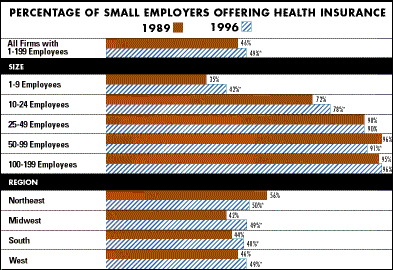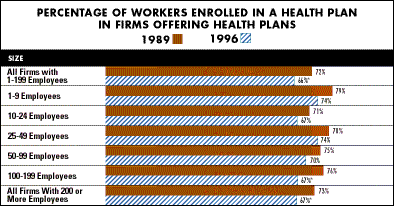
More Small Firms Offer Health Insurance but Fewer Employees Enroll
Data Bulletin No. 10
Winter 1998

Sources: Health Insurance Association of America, 1989;
KPMG Peat Marwick, 1996.
* Difference from 1989 level is statistically significant at 95 percent level.
 oncerns about the ability of employment-based insurance to play a key role in covering the
population have focused on the willingness and ability of small firms to offer health
insurance. The good news is that in the 1990s, small firms became more likely to offer
health insurance to their employees. (Small firms are defined here as those with fewer
than 200 employees.) According to an employer survey, the proportion of small firms with
coverage for workers grew from 46 percent in 1989 to 49 percent in 1996. This increase
was most pronounced among the smallest firms - those with fewer than 10 employees. Overall,
health insurance became more uniformly available in small firms in regions across the
country; in 1989, there were greater disparities, with coverage more likely to be offered
in the northeast than any other region.
oncerns about the ability of employment-based insurance to play a key role in covering the
population have focused on the willingness and ability of small firms to offer health
insurance. The good news is that in the 1990s, small firms became more likely to offer
health insurance to their employees. (Small firms are defined here as those with fewer
than 200 employees.) According to an employer survey, the proportion of small firms with
coverage for workers grew from 46 percent in 1989 to 49 percent in 1996. This increase
was most pronounced among the smallest firms - those with fewer than 10 employees. Overall,
health insurance became more uniformly available in small firms in regions across the
country; in 1989, there were greater disparities, with coverage more likely to be offered
in the northeast than any other region.
This accomplishment was more than offset, however, by the decline in the proportion of
employees enrolling in employer-based coverage. The result: a net decline in the rate
of employment-based health coverage. This is true for persons working in large firms as
well. Findings from a household survey using data from 1987 and 1996 confirm this
trend.1

Source: Health Insurance Association of America, 1989;
KPMG Peat Marwick, 1996.
Note: All figures weighted by number of employees.
* Difference from 1989 level is statistically significant at 95 percent level.
ENROLLMENT TRENDS
 he percentage of employees in small firms enrolled in their firms’ plans decreased from
72 percent in 1989 to 66 percent in 1996. (See chart below.) This decline occurred
relatively uniformly across all small firms and among large firms as well.
he percentage of employees in small firms enrolled in their firms’ plans decreased from
72 percent in 1989 to 66 percent in 1996. (See chart below.) This decline occurred
relatively uniformly across all small firms and among large firms as well.
Another measure of employees’ lack of interest in coverage comes from the perspective of
their employers. When employers that do not offer health insurance coverage were asked
the major reasons for not doing so, 33 percent of the small firms responding to a 1996
survey said it was because employees are not interested - an increase over 1989, when 29
percent responded this way.
Why are employees declining health coverage? Perhaps the major reason is the sharp
increase in the size of the contribution required from employees. This increase is driven
by two factors: increases in premiums and the proportion of premiums paid by employees.
Overall, the average monthly contribution for family coverage for workers in small firms
increased from $34 in 1988 to $175 in 1996. This represents a 23 percent increase per year
on average.
These contributions have been rising faster than wages. The problem is exacerbated because
employees who are most sensitive to these increases are those with the lowest wage; they
also have experienced the smallest gains in earnings in recent years. Simply put: they
cannot afford health insurance.
IMPLICATIONS FOR POLICY MAKERS
 ased on these survey findings, health policy makers may have to take a new look at how
to deal with the problem of uninsurance. Many of their efforts to date have been
associated with ways to encourage small firms to offer health insurance coverage;
there has been some progress on that front. At the same time, the fact that the cost of
health insurance has been rising more rapidly than earnings has taken an important toll
on health insurance coverage.
ased on these survey findings, health policy makers may have to take a new look at how
to deal with the problem of uninsurance. Many of their efforts to date have been
associated with ways to encourage small firms to offer health insurance coverage;
there has been some progress on that front. At the same time, the fact that the cost of
health insurance has been rising more rapidly than earnings has taken an important toll
on health insurance coverage.
Given that most forecasts show a resumption of the trend of health insurance premiums
to grow faster than incomes, this relationship is worrisome and is likely to get worse.
Making progress in containing health care costs is probably more important to expanding
or preserving the rate of health insurance coverage than previously believed.
Note
1. Cooper, P. F., and B. S. Schone. "More Offers, Fewer Takers for Employment-Based Health Insurance: 1987 and 1996." Health Affairs (November/December 1997): 103-110.
This Data Bulletin is based on data from KPMG Peat Marwick’s national survey of all employers
of all sizes, Health Benefits in 1993 and Health Benefits in 1996, and from the Health Insurance Assocation
of America in 1989. The KPMG and HIAA surveys used a similar questionnaire, sample design and set of statistical weights.
Survey interviews were conducted by telephone.
This Data Bulletin is adapted from "Tracking Small-Firm Coverage, 1989-1996," by Paul B. Ginsburg,
John R. Gabel and Kelly A. Hunt, which appeared in the January/February 1998 issue of Health Affairs.


